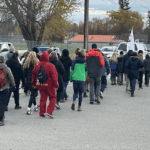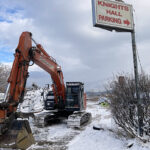Home »

A collaborative approach to forest management
Kootenay Conservation Program
Kari Stuart-Smith, a wildlife ecologist and Manager of Biodiversity & Wildlife at Canfor, has dedicated over 30 years to advancing sustainable forest management in the East Kootenay. Her career reflects a commitment to integrating ecological values into forest practices.
Stuart-Smith emphasizes the importance of collaboration in creating long-lasting change. “The strongest solutions to the complex forest management challenges we face today are those that we develop together, based on a diversity of opinions and ideas.” This approach has guided her work in developing innovative strategies that balance ecological integrity with industry needs.
One way to find common ground that Kari feels can be very successful is collaborative field trips where representatives from various organizations go out into the forest together to discuss the values present and how to manage for them. Kari admits that this is not always an easy task, and that people do not always agree at the end, but she emphasizes the value of bringing people together to discuss their perspectives in place.
One of her notable initiatives is the development of a new Old Growth Management Plan for Canfor’s Tree Farm License (TFL) 14 southwest of Golden.
This project involved a collaborative group from Canfor, the Province of BC, First Nations, and Wildsight, with technical guidance from Forsite. Using LiDAR data to assess forest stand structure, the team identified high-quality old growth areas, leading to a plan with higher ecological values than previous models.
The plan has been successfully implemented for nearly two years, and based on the success of this pilot, Canfor is now working with an expanded collaborative group (including BC Timber Sales) on a similar old growth project for the Cranbrook and Invermere Timber Supply Areas, which is being led by the Ministry of Forests and Forsite.
Identifying high conservation value areas
Stuart-Smith also played a key role in identifying and developing management strategies for High Conservation Value Areas (HCVAs) in the East Kootenay, a requirement for Forest Stewardship Council (FSC) certification. She initiated a collaborative team comprising The Nature Trust of BC, Nature Conservancy of Canada, Wildsight, government representatives, Canfor, and wildlife experts like Dr. Michael Proctor. Together, they identified biodiversity hotspots and developed management strategies to maintain or enhance their values.
Some HCVAs are extensive, over 10,000 hectares, and include areas where no logging or road building is permitted due to their high conservation values. Stuart-Smith notes, “Some of these areas are phenomenal habitat for grizzly bears, mountain goats, and wolverine, and we know that high road densities are not compatible with maintaining high-value habitat for these species.”
Stuart-Smith says she got into forestry because she always wanted her work to make a difference in terms of positive change in forest management on the ground.
Her academic journey includes a Master of Science in Zoology from the University of Alberta, and a PhD in Forest Science from Oregon State University. Her doctoral research in the East Kootenay focused on the effects of tree retention within cutblocks and wildfire burns on songbirds. The findings led to changes in logging practices to increase tree retention – including overstory, understory, and deciduous trees – benefiting various bird species.
Her contributions to the field have been recognized with several awards, including the National Women in Forestry Award of Excellence by the Forest Products Association of Canada in 2023 and Canfor’s ‘Gamechanger’ President’s Award in 2024. She was appointed to BC’s first Minister’s Wildlife Advisory Council in 2021, which provides expert advice to the Minister of Water, Land, and Resource Stewardship on the implementation of the Together for Wildlife Strategy and policies impacting wildlife and their habitat.
A message for future forest managers
Stuart-Smith encourages younger individuals to consider careers in forest management, highlighting the field’s dynamic nature and the opportunities it presents for making meaningful contributions. She states, “Forest management is a wonderful career with lots of opportunities. The field is changing tremendously fast right now, and there are great opportunities to make significant changes going forward and have fun while doing so.”
Outside of her professional endeavours, Stuart-Smith enjoys hiking into the alpine, birdwatching, traveling, skiing, and reading. Her passion for the natural world extends beyond her work, reflecting a deep commitment to the environment.
Kari Stuart-Smith’s career exemplifies the integration of science, collaboration, and practical application in forest management. Her work continues to influence sustainable practices in the East Kootenay region and serves as a model for future forest management professionals.
Photo submitted
Kootenay Conservation Program (KCP) is a partnership of over 85 organizations that work together for connected habitats and landscapes in the Kootenays that sustain biodiversity and naturally functioning resilient ecosystems that, in turn, support community well-being. Learn more at www.kootenayconservation.ca.







